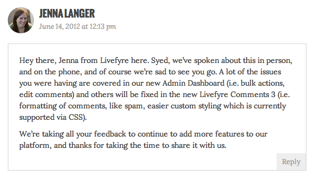“What I Learned From Liars and Journalists, and How it Made Me a Better Blogger” plus 1 more |  |
| What I Learned From Liars and Journalists, and How it Made Me a Better Blogger Posted: 30 Aug 2012 01:09 PM PDT This guest post is by Austin Gunter, of WP Engine. Trust Me, I'm Lying – Confessions of a Media Manipulator is the title of Ryan Holiday's new book about the tactics cutting-edge bloggers use to drive hundreds of thousands of viewers to their blogs, seven days a week, 365 days a year. Ryan, author of controversial posts like The Top 5 Performing American Apparel Ads, And How They Get PR For Free (NSFW), is the Director of Marketing at American Apparel, and is a self-proclaimed "media manipulator." He has made a high-flying career serving irresistible blog content to places like the Huffington Post, Gawker, and Jezebel. I waited more than a year for Trust Me, I'm Lying to hit the shelves. The book has pushed my limits as a marketer and as a person from the second it arrived in my mailbox. You must read the book. I've personally poured through the book late at night to wring every last bit of knowledge from its pages and make my own blogging irresistible. From my reading, I've picked out a set of unexpected tactics that I want to share with the Problogger audience. In this post, we'll go in-depth with these unexpected methods, how you can use them to make your page views spike every single day. Way back in history…Way back in American History, nearly 150 years ago, newspapers were run by incredibly brilliant marketers. Folks like William Randolph Hearst and Joseph Pulitzer learned how to sell newspapers one copy at a time using headlines and sensational stories to entice businessmen to spend their hard-earned money on a paper. 19th century newspapers like The New York Sun and The New York Journal were sold one paper at a time, their success riding on how compelling the front page was. The more engaging the content, the better the paper sold. Sound familiar? That's because blogs live and die by the pageview. Every page on a blog has to stand on its own, or get lost in the shuffle of the Internet. Blogging and the "Yellow Journalism" of the mid-19th century are ridiculously similar. Selling newspapers one copy at a time, in the hustle and bustle of the already-hectic, and often inhospitable island of Manhattan, for example, is the same hustle that bloggers must have to be successful. There's money to be made, but how is a single blog supposed to stand out from the crowd and draw page views amidst the hustle and bustle of Twitter, Facebook, and Business-Insider's link-bait photo galleries? How did The New York Journal and The New York Sun sell millions of copies of their papers? And how can you, the blogger, use old-school journalistic tactics and a bit of sensationalism to draw traffic to the valuable content of your blog? Here are some suggestions. Yellow journalism tactics that generate pageviewsBefore I lay out these incredibly powerful blogging tactics, I want to issue a warning. While the methods we're about to explore flat-out work, and can generate six-figure pageviews for your blog, many of them are inspired by the dark history of American journalism. Please know your limits before you go crazy injecting your writing with the the methods I share with you in this post. Focus on the fearUse headlines that might threaten your audience's way of life. Fear is a powerful motivator for immediate action. Writing a headline that invokes fear makes it nearly impossible for your audience to look away. This example from The New York Journal shows an irresistible headline. Get news faster"Special Edition" papers that broke the news sold in incredible numbers. Social media platforms make breaking news a minute-by-minute affair. If you can publish the story immediately, you benefit from the pageviews.
Even if the story is you sharing your opinion, you still posted first. As The Huffington Post advertises on their homepage: "Breaking News and Opinion…" Get exclusivesCan you publish a story that nobody else can access? The story must be relevant and valuable to your audience, so if you write about WordPress, your exclusive can't be about Fantasy Football. But, if you have the inside scoop on WordPress 3.5, or you run an Apple Rumor blog and you know about secret bug fixes in Mountain Lion, that's big news that literally millions of people care about. Ask the question, "Would this exclusive affect my audience's business or behavior?," if you're unclear whether the exclusive will be attention-grabbing. Give away the story in the headlineYou want the headline to contain the entire story. If you can tell the whole story in the headline, you'll still get the click. The art is in succinctly telling the story, with details, in about 110 characters, short enough to fit into a tweet without editing. Here's a 19th century example from The New York Journal: "CALL TO DUTY: 250,000 VOLUNTEERS ARE ASSIGNED TO WAR STATIONS. Preparing for the final blow at Cuba, New York Furnishes Twelve Regiments." Here's a recent one from The Huffington Post this August: "A PALL OVER PAUL. GOP PROS FUME: Romney Ceded Election With Ryan Pick." That's a headline built for tweeting. Embrace the controversyJust like fear, outrage is a powerful motivator. The perfect recipe for controversy is to highlight the extreme position of a particular issue. Nuance won't inspire immediate action, and unfortunately anything that takes longer than "immediately" takes too long to tweet. Politics has always been a good way to stir the controversy. Take this headline for example: "BOTH HOUSES, In Uproar, Threatening Revolt, WARN M'KINLEY" The emphasis is from the headline, not my own. Notice how the upper-case words focus the reader on the controversy at hand, while the lower-case words contain the nuance that requires a bit more time to process? Don't be limited to the politics of presidential elections. Your online community has its own politics that you can engage. If the content gets people talking in the comments, there was a good chance it was controversial. For example, this recent post engages the gender controversy, and generates some rather insightful and open discussions in the comments. Use pictures!Call it Industrial Revolution Link-Bait. The front pages of The New York Journal were full of images designed to push the limits on cultural mores, including illustrations of nearly-nude women and explosions from the wars that were happening. By contrast, here's a post I wrote about the bodies of the summer Olympic athletes. ConclusionThe tactics that I've laid out here are inspired by Ryan Holiday's exposé of the industry, Trust Me, I'm Lying. I've only scratched the surface of what he covers in the book, which is recommended reading for writers, from PR to bloggers, to community mangers, making their livings on the Internet. Many of these tactics are controversial at best, and some of them may push our boundaries as writers. My goal isn't to write a post that makes you feel comfortable, but instead to provide insight into what it takes to generate page views for your blog. I do encourage you to know where your own limits are, and to decide how you want to define "success" for your online content. Blogs live and die by the page view, just like Yellow Journalism, which was measured based on how many papers were sold each day. The question is: how much is one page view worth to your site? Tell me in the comments how far you're willing to go for a click. I'm curious to see the spectrum of spectacle. On balance, who is a successful blogger that would never use any of these tactics? Austin Gunter is a blogger, a writer, and a massive extravert. He works and lives as the Brand Ambassador for WP Engine, managing the marketing, branding, and PR for their Managed WordPress Hosting Platform. Austin drinks yerba maté daily and is really good at twitter You should follow him, @austingunter. His own WordPress is found at austingunter.com. Originally at: Blog Tips at ProBlogger What I Learned From Liars and Journalists, and How it Made Me a Better Blogger |
| The Problem with Almost All Blogs—and An Easy Solution Posted: 30 Aug 2012 07:03 AM PDT This guest post is by John Trayhorn of the ECHO Affiliate Blog. This post describes a problem that affects almost all bloggers, and almost certainly affects you. Implement these changes, and you should see page views, revenues and social sharing soar. How it beginsYou start off a great blog. To start with almost nobody reads it. Hey, it takes time to build up an audience. (If you've just started, don't give up—longevity is one of the keys to a successful blog!) As time passes, you slowly gain an audience. When you publish a new blog post, you get a surge of readers. But:
There's a solution. What's more, it's easy to implement, has huge benefits and doesn't take a lot of your time. The solution to the problemI first found the solution when I ran an Adsense website. I noticed that most of the revenue came from our articles about jobs. We were already using an autoresponder website to send out our newsletters. But to maximise revenue, we needed to do something more. Email blogging, done rightYou may well have heard of autoresponders, or use one yourself, but hang on in with me—there's more to it than sending out a few emails when you write a new blog post, or have something to sell. Instead, you send out an email about every post you have ever written. Not at the same time, of course. If you have an old blog with a lot of posts, the process could be spread out over years! And don't include the post in the email—the aim is to get the reader back to your blog. Instead, explain how each blog post will create value to your reader, and then include a link with a call to action back to the post. Remember to use a fantastic headline and to test these over time, so you get more and more opens—and more and more clickthroughs. In my case, I took all our jobs articles, organised them into a logical sequence, emailed users about them over a couple of months, and watched our Adsense revenue explode from a few few hundred dollars to a peak of just under $3000. You can see an example of one of our autoresponder emails here: As I found out later, this approach works even better if you have a high-value product to sell. Benefits for you, benefits for your readersThink of this:
What's more, an increase in regular visitors leads into other benefits, such as:
This approach does require a change of emphasis on your blog. If you use this technique, your primary goal should be to get readers to sign up, not just to read. You will also need to create a clear benefit to signing up, such as a free guide, an email course or, if you are selling a product, discount codes. (An email course can be as simple as your existing blog posts organised into a more logical sequence.) Don't think you are being selfish, either. There are clear benefits to the reader, who gets an organized sequence of free blog posts about a topic they’re interested in. Have you used autoresponders to get traffic to your old posts? Tell us how it worked in the comments. You can read more tips like this on the ECHO Affiliate Blog. And, of course, make sure you sign up so you get all of our fantastic tips via auto-responder! Originally at: Blog Tips at ProBlogger The Problem with Almost All Blogs—and An Easy Solution |
| You are subscribed to email updates from @ProBlogger To stop receiving these emails, you may unsubscribe now. | Email delivery powered by Google |
| Google Inc., 20 West Kinzie, Chicago IL USA 60610 | |














.jpg)